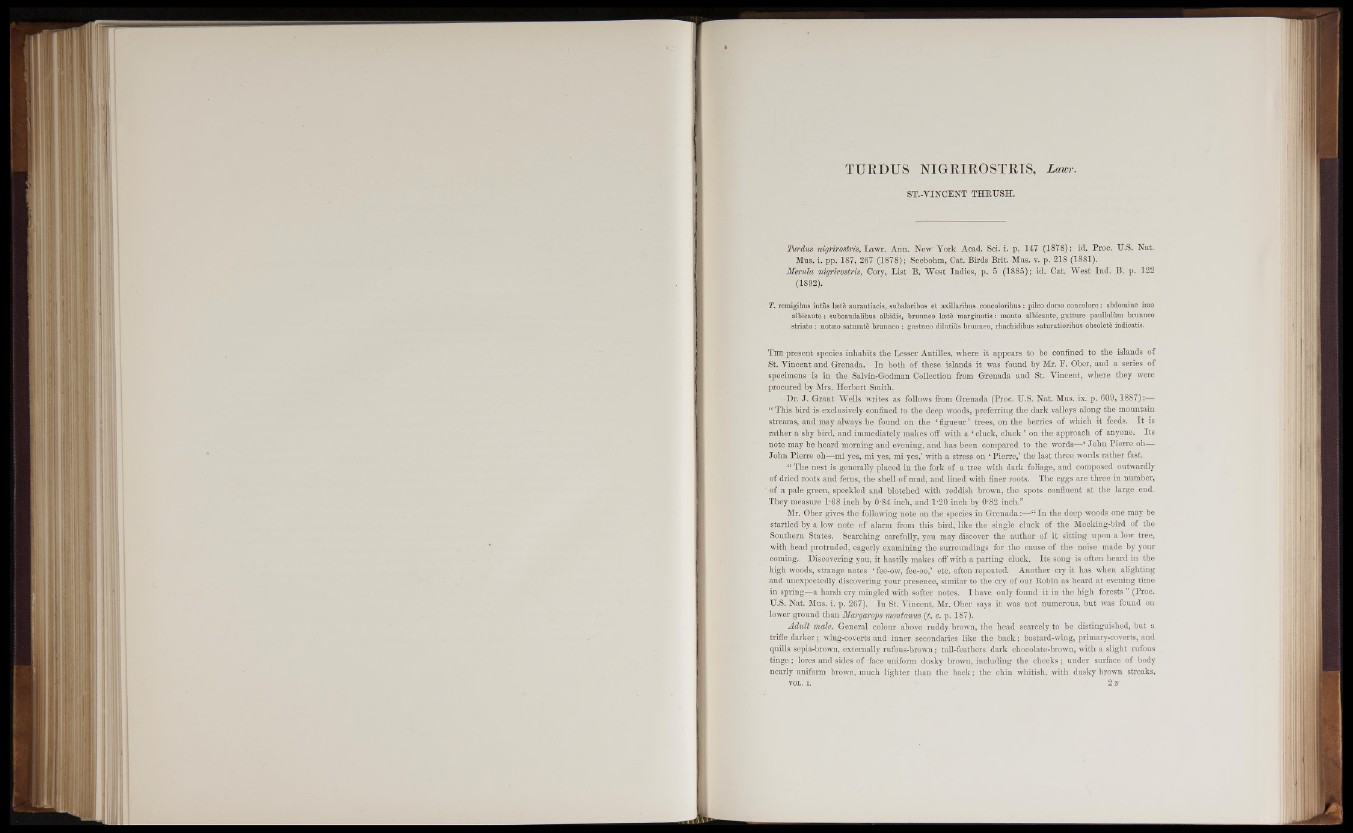
n n
i l l !
*
I I
S f i l Hi i St
w iia a
TURDUS NIGRIROSTRIS, Lam-.
ST.-YINCEWT THRUSH.
Turdus nigrirostris, Lawr. Ann. New York Acad. Sci. i. p. 147 (1878); id. Proc. U.S. Nat.
Mus. i. pp. 187, 267 (1878); Seebohm, Cat. Birds Brit. Mus. v. p. 218 (1881).
Merula nigrirostris, Cory, List B. West Indies, p. 5 (1885); id. Cat. West Ind. B. p. 122
(1892).
T. remigibus intus laete aurantiacis, subalaribus et axillaribus concoloribus : pileo dorso concolore: abdomine imo
albicante: subcaudalibus albidis, brunneo laete marginatis: mento albicante, gutture paullulum brunneo
striato : notaeo saturate brunneo : gastraeo dilutius brunneo, rbacbidibus saturatioribus obsolete indicatis.
T he present species inhabits the Lesser Antilles, where it appears to be confined to the islands of
St. Vincent and Grenada. In both of these islands it was found by Mr. F. Ober, and a series of
specimens is in the Salvin-Godman Collection from Grenada and St. Vincent, where they were
procured by Mrs. Herbert Smith.
Dr. J. Grant Wells writes as follows from Grenada (Proc. U.S. Nat. Mus. ix. p. 6 0 9 ,1 8 8 7 ):—
“ This bird is exclusively confined to the deep woods, preferring the dark valleys along the mountain
streams, and may always be found on the * figueur ’ trees, on the berries of which it feeds. It is
rather a shy bird, and immediately makes off with a * cluck, cluck ’ on the approach of anyone. Its
note may be heard morning and evening, and has been compared to the words—‘ John Pierre oh—
John Pierre oh—mi yes, mi yes, mi yes,’ with a stress on * Pierre,’ the last three words rather fast.
“ The nest is generally placed in the fork of a tree with dark foliage, and composed outwardly
of dried roots and ferns, the shell of mud, and lined with finer roots. The eggs are three in number,
' of a pale green, speckled and blotched with reddish brown, the spots confluent at the large end.
They measure 1*68 inch by 0*84 inch, and 1*20 inch by 0*82 inch.”
Mr. Ober gives the following note on the species in Grenada:—“ In the deep woods one may be
startled by a low note of alarm from this bird, like the single cluck of the Mocking-bird of the
Southern States. Searching carefully, you may discover the author of it sitting upon a low tree,
with head protruded, eagerly examining the surroundings for the cause of the noise made by your
coming. Discovering you, it hastily makes off with a parting cluck. Its song is often heard in the
high woods, strange notes ‘ fee-ow, fe_e-oo,’ etc. often repeated. Another cry it has when alighting
and unexpectedly discovering your presence, similar to the cry of our Robin as heard at evening time
in spring—a harsh cry mingled with softer notes. I have only found it in the high forests ” (Proc.
U.S. Nat. Mus. i. p. 267). In St. Vincent, Mr. Ober says it was not numerous, but was found on
lower ground than Margarojps montanus {t. c. p. 187).
Adult male. General colour above ruddy brown, the head scarcely to be distinguished, but a
trifle darker; wing-coverts and inner, secondaries like the back; bastard-wing, primary-coverts, and
quills sepia-brown, externally rufous-brown; tail-feathers dark chocolate-brown, with a slight rufous
tinge; lores and sides of face uniform dusky brown, including the cheeks; under surface of body
nearly uniform brown, much lighter than the back; the chin whitish, with dusky brown streaks,
vol. i. - 2 N